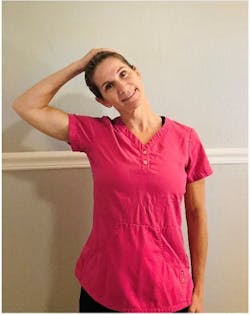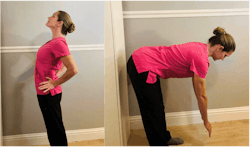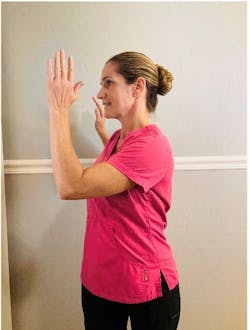Wellness Corner: Teams that stretch together, stay together
Imagine a team who starts the day energized from a morning huddle that leaves them feeling physically prepared to provide excellent care without being exhausted by the end of the day! It doesn’t take long in any position on the dental team to know firsthand about the balancing act between caring for patients and keeping the body pain free. This constant struggle of chronically tight muscles and fatigue is our opponent, and body preparation is a big part of the plan that brings the team a win—especially when we do it together.
Why together? The most obvious reason is accountability. It’s easy to let small acts of self-care go out the window when we’re running late or are tired, but when we perform those acts together, it’s simply part of the day.
Another compelling reason is to establish an office culture of workplace wellness. When we make wellness a priority, that mindset is passed on to our patients in a ripple effect. It may come out in casual conversation that the stretch we did today felt great after the long procedure yesterday afternoon.
Last, and most importantly, the effect of feeling less pain and fatigue that leads to better patient outcomes and advocacy is contagious! We feel better as a team rather than as just one or two individuals.
The most common pain points for dental professionals are neck (59.9%), shoulders (43.3%), lumbar region (52.1%), dorsal region (37.7%) and wrists (30.6%).1 This pain is most commonly developed from chronically tight muscles and dysfunction from awkward posture, contact stress, force, repetition, and vibration.2 Perhaps we should take three minutes of the morning huddle to prepare these five high-risk body parts with a stretch. We may start the day preventing discomfort for more than our patients.
Neck stretch
As the number one pain point for dental professionals, let’s make this one a priority and do it first. Unless we’re wearing deflective loupes (doctors and hygienists) or have our monitors on properly adjusted risers (front desk), we spend a tremendous amount of time looking down. Even a 20° downward chin tilt is a strain on the neck. We need to maintain mobility and the natural curvature in the cervical spine.
The neck stretch:
- Tilt the head toward your nondominant side, bringing the ear toward the shoulder while keeping the dominant shoulder down.
- Use the nondominant hand to apply a little pressure to your head to a place of slight discomfort, not
- Hold for 15–30 seconds while breathing slowly, and then switch sides.
- Point the chin up to the ceiling and then roll the head back from one side to the other and hear the neck crepitus popping!
Shoulder stretch
If a team member uses a keyboard or works in the mouth, the shoulder is likely to become tight over time due to the concentration of work being at the body’s midline with hands internally rotated. The chest muscles lend to this discomfort in that they also become tight and pull on the smaller shoulder muscles, which lose the battle every time.
The shoulder stretch:
- Stand with elbows down at the sides, hands up with palms facing forward.
- Bring only the hands backward for 15–30 seconds.
- Next, bring the elbows up so that the biceps are parallel to the ground, and bring the elbows backward while breathing slowly for 15–30 seconds.
Lumbar stretch
We feel the aches in the low back from sitting all day—especially for those team members who sit for hours at a time. The shortening of the hip flexors and tightening of the spinal muscles become tight from sitting. The hips are essentially the hinge between the upper and lower body, so when we sit for long periods of time, the hinge can feel rusty and stuck.
The lumbar stretch:
- While standing, place the hands on the low back and push the hips forward for 15–30 seconds, and return to standing
- Maintain a straight back and hinge forward at the hips, allowing the arms to hang down. Continue to hinge forward until the spine starts to round.
- Breath slowly while stretching the low back for 15–30 seconds
Mid-back stretch
The mid-back is where the hunch begins to resemble Mr. Burns, from developing extra connective tissue to hold the 10–12 lb. head onto the spine and lean to one side (clinicians) for prolonged periods of time. We develop pathological dysfunction and pain from one side being contracted and the other being relaxed.
The mid-back stretch:
- While standing with hands on hips, twist the upper body clockwise, bringing one shoulder forward to one side and the other shoulder backward.
- Maintain hips facing forward throughout the stretch for 15–30 seconds.
- Stretch the other side in a counterclockwise direction.
Wrist stretch
The hands are the moneymakers in everything we do. Without them, we cannot work, yet these incredibly important body parts get constant pinch grip, force, and contact stress in flexed positions for prolonged periods of time.
The wrist stretch:
- Bring one hand out in front in an extended position (fingers pointed up) and use the other hand to apply pressure to the palm for 15–30 seconds.
- Next, slide the other hand up the palm and apply pressure to the fingers for 15–30 seconds.
- Last, don’t forget the thumb! Apply pressure to extend the thumb backward for 15–30 seconds.
Incorporating these and other yoga-type stretches into your daily routine can make a world of difference in injury prevention and comfort.3 Do one or do them all, but make sure to stretch in your morning huddle to feel better, maintain the energy to advocate better, and deliver better care! A wellness mindset may be exactly the culture change your team has been looking for to create a pain-free workplace.
Editor’s note: This article first appeared in Clinical Insights newsletter, a publication of the Endeavor Business Media Dental Group. Read more articles and subscribe.
References
- Gandolfi MG, Zamparini F, Spinelli A, Risi A, Prati C. Musculoskeletal disorders among Italian dentists and dental hygienists. Int J Environ Res Public Health. 2021;18(5):2705. doi:10.3390/ijerph18052705
- Ergonomics. Identify problems. Occupational Safety and Health Administration. U.S. Department of Labor. Accessed October 7, 2024. https://www.osha.gov/ergonomics/identify-problems#risk-factors
- Gandolfi MG, Zamparini F, Spinelli A, Prati C. Āsana for back, hips and legs to prevent musculoskeletal disorders among dental professionals: in-office yóga protocol. J Funct Morphol Kinesiol. 2023;9(1):6. doi:10.3390/jfmk9010006
About the Author

Katrina Klein, RDH, CEAS, CPT
Katrina Klein, RDH, CEAS, CPT, is a 15-year registered dental hygienist, national speaker, author, competitive bodybuilder, certified personal trainer, certified ergonomic assessment specialist, and biomechanics nerd. She’s the founder of ErgoFitLife, where she teaches that ergonomics and fitness are a lifestyle to prevent, reduce, and even eliminate workplace pain.








